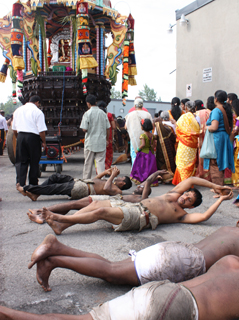2 Aug
Sticking a skewer though one’s cheek could be one of the weirdest things people do to themselves. So is hanging oneself suspended by hooks through one’s back.
I’ve never understood the reason why until last month in Scarborough. A few people there were doing one or the other. It was at the annual Chariot Festival at the Sri Varasiththi Vinaayagar Hindu Temple just north of Finch and McNichol.
It’s hard to have a conversation with people who look like they might be in pain. I didn’t talk with the man hanging from what looked like a giant, fishing rod. Though he was smiling, he was too busy being bounced up and down.
I tried to talk with one of the half-dozen men with the cheek skewers and the ropes attached to their backs. He did say he couldn’t talk at the moment and referred me to the man pulling on his ropes. The friend explained that the skewer was to keep him from talking. He was concentrating on God.
The men were dancing or bouncing to help them attain happiness or a full life, the friend said. It was their way of praying for a favour, or to thank God for a request granted. For some, it was to appease God for sinning.
His answers brought thoughts to my mind of medieval Christian monks thrashing themselves. A handful of Filipino Christians crucify themselves on Good Friday even today. Muslims celebrate Ramadan, their month of fasting, for similar reasons. The punishments were different but all had similar purposes.
Men and women were pulling a big chariot at this festival for the same reasons. Six men were following the chariot, rolling their bodies on the hard, uneven pavement. A group of women in brilliantly coloured saris balanced jugs of milk on their heads. After the procession, they would pour the milk as an offering over the statue of God Ganesh. Some were carrying bowls of burning camphor. A dozen men and women sang sacred songs and beat drums.
The whole parade of at least a thousand people moved slowly, with many stops and starts. They completed the tour around the industrial complex in about two hours. The temple is temporarily located in the industrial complex.
Every 20 minutes or so, the men with the hooks in their backs danced to the lively music. Only one looked like he was in pain. One of the chariot pullers was carrying a first-aid kit. A woman said men in Sri Lanka keep the hooks attached to their bodies for over five hours. In Toronto, it’s only three. She also talked about a second Tamil temple in Toronto that organizes a similar festival.
This amazing festival was one of the highlights of my efforts to photograph the customs of Toronto’s many diverse cultures. It was something I would have looked for on a visit to Sri Lanka. I didn’t expect to find it in Toronto. It was especially wonderful because the Tamils made me feel welcome. I was greeted by a man who asked if I was from the media. He was eager to answer questions. I didn’t need to ask him any questions. People around me were helpful with explanations. Many people were eager to pose for my camera. I wish I had time to join them in the meal afterwards. It too was free of charge.
If you go next year, just wear heavy socks and leave your shoes at the entrance. Most people were barefoot. The grounds were sacred but rough.
The temple’s web-site: www.vinaayagar.com. See also Blog. 153.






I think that I first saw a Thaipusam parade in 1968 in Kathmandu and then in 1974 in Sri Lanka. The sight of participants in trance-like state, with skewers through their cheeks and mouths and cage-like contraptions sticking knives into their chests and backs, fascinated and horrified the viewers. One cannot help being amazed at the kinds of acts of petition or gratitude people will commit.
I like the valuable information you provide on your articles.
I will bookmark your weblog and test again here regularly.
I am fairly sure I will be told many new stuff proper here!
Good luck for the following!